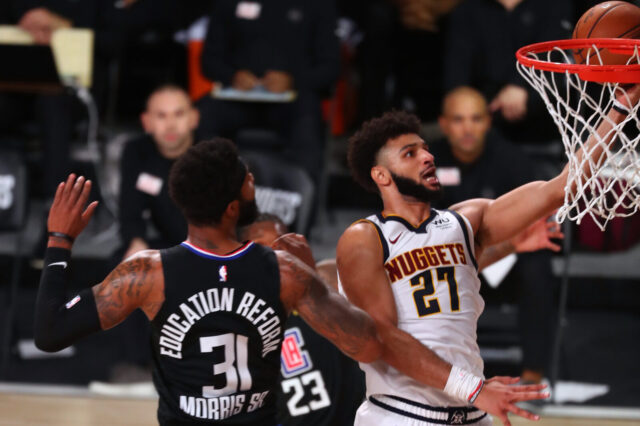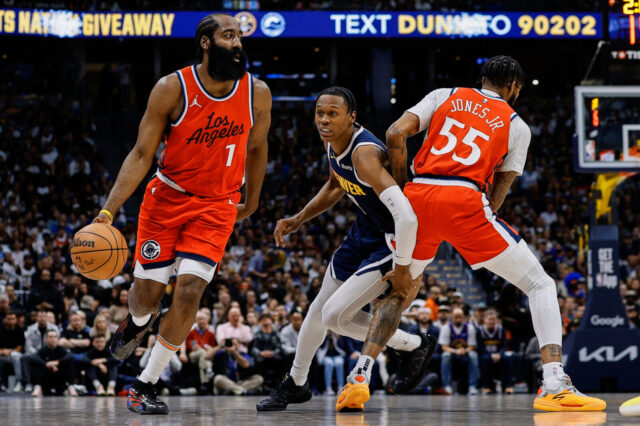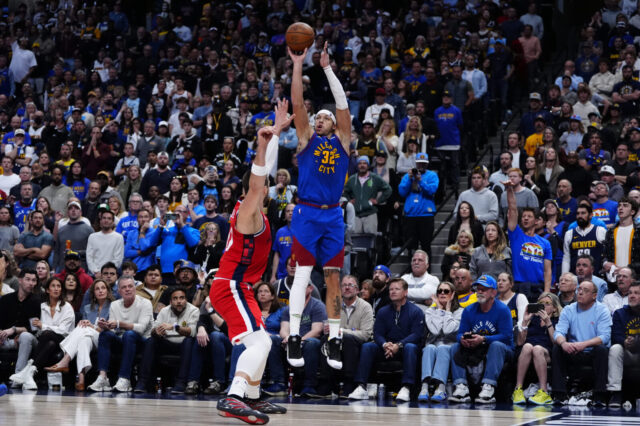There are three main components to the Denver Nuggets’ “Horns Flex” play. The first two are right in the title. “Horns,” the term used to describe the formation that the Nuggets are in to begin the play, with a wing in each corner, a big on each wing, and a point guard at the top of the key. And “Flex,” the term used to describe the cross court cut from the corner to the opposite block. The third component is a screen-the-screener (STS) action that was discussed in the previous edition of this series.
Let’s take a close look at how this play unfolds and the many different details that make it an effective play with lots of reads and variations.
Quick pass on the flex cut
The first option out of this play is to hit the corner wing off of the flex cut. In the first example, Jamal Murray sets the screen for Will Barton who gives Kevin Durant a wide-receiver like shimmy before releasing across the paint to the opposite block, creating just enough space for Nikola Jokic to sneak in a bullet pass. In the second example, Murray sets a much more solid screen for Wilson Chandler. This time Jokic delivers the pass high and outside, just out of the reach of the defender.
It’s interesting to watch how Murray’s “screen” is different in each example. Both plays are the first play of the game so the coaching staff likely prepared subtle tweaks to the play based on opponent tendencies. Steph Curry trails Murray as he cuts across the paint, anticipating Murray’s release to the three-point line. In contrast, Russell Westbrook jumps the release to get between Murray and the ball, providing less help on the cutter from the corner but better preventing Murray from moving on to the next step of the play.
Elbow jumper
Part of why this play is so deadly is because Denver has players who are a threat to score from every spot in the sequence. Here, Darrell Arthur is a stand-in for Paul Millsap. The Spurs elect to sag off of Arthur and clog up the paint to prevent the flex cut from becoming an option. This isn’t a sustainable option against the Nuggets since Millsap is an excellent shooter from the elbows and can even extend his spacing out to the three-point line on the wing. Defenses have to stay honest against all five guys.
Main option
This is the shot that the play is designed to create. In both examples, the point guard shows the screen for the cutter in the corner but slips out above the break before the defense can communicate the screen. In the first example, Jabari Parker loses Chandler on the cut and then fails to recognize the switch is being called out by his teammate. They don’t pay players to play defense. Devin Harris exasperates the issue by slipping the screen with a nice change of speed.
In the second example, the Spurs don’t appear to be playing the switch. Instead, Dejounte Murray anticipates the flex cut and lags behind Jamal in the paint to slow the cutter. So when Jamal slips the screen and sprints out to the three-point line, Dejounte is in no position to recover. This is the result Denver is looking for and one of the reasons this is such a popular set to open up games. It is very difficult for the defense to defend both the flex cut and the release to the there-point line and what better way to open up a game than with a layup or a three?
1-5 switch
Because this play is so good at forcing the defense to chase the play, one common outcome is that the defense will switch the final down screen between Murray and Jokic. Very few teams will make this switch unless they absolutely have to but more often than not, defenses have to.
This is an ideal outcome for Denver since it places a point guard onto Jokic and a center onto Murray. In the clip below, watch how smoothly Jokic transitions from the dribble handoff (DHO) into the post-up. From that point on, the Nuggets are just playing basketball. Jokic knows that a quick double-team is coming. Murray knows to cut through because DeAndre Jordan will not be able to track him for very long without being completely taken out of the play. Gary Harris slides to the open spot along the wing, making room for Will Barton in the corner. And Wilson Chandler makes one of my favorite plays in basketball as he sets a blind screen on the help side defender (although he probably could’ve held the screen a split second longer).
Right into a DHO
The dribble handoff option is probably the second most common outcome out of this set. The defense does a good job of jamming Barton on the cut, throwing off the timing of the screen and slip. Because of that, Eric Bledsoe is able to stay fairly connected to Murray, taking away the “main” option. But Jokic and Murray do a great job of reading the play and segue right into a DHO, forcing Bledsoe to fight through yet another screen, creating another step of separation between him and Murray.
Here is where things get the most interesting. Murray gets into the paint and is able to decide between three basic reads. If the rim protector stays close to the roll man (in this case, Jokic) then Murray can take the shot. If he steps up to stop the drive, then Murray can drop it off to Jokic. And if a third defender enters the paint to help stop dribble penetration…
Kickout to the corner
…the kickout to the corner is wide open.
Post entry option
Like any great play, there are a lot of different wrinkles that a team can add to the base design of this play to get different looks. In the clip above, Jokic and Murray don’t even look to go into a DHO like they did in the previous examples. Instead, Murray looks straight at Millsap in the post once he catches the ball at the top of the key.
The Thunder didn’t switch the play so this option is basically a straight isolation post-up for Millsap against Carmelo Anthony. It appears as though Jokic and Murray attempt to execute some kind of off-ball screen and rescreen to get Murray open for a kickout, an option that might’ve worked had Barton been on the same page and stayed put out on the opposite wing. Fortunately, Millsap is able to make the tough fallaway, one of his signature shots from one of his favorite spots on the court.


